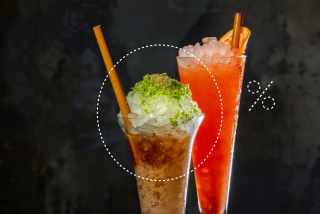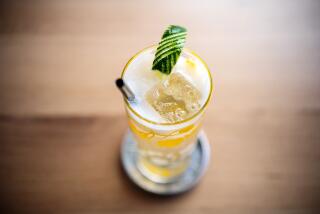Time for a Non-Alcoholic Brew? : Vintner Tries Hand at a Beverage That’s Not Quite Beer
- Share via
When Brooks Firestone says “Gimme a light,” he’s talking light.
Like no alcohol at all.
Firestone, a Santa Ynez Valley vintner and scion of the tire fortune family, has joined forces with brewing expert Hale Fletcher to produce a non-alcoholic beer that will be released in 12 Western states within 60 days.
The name of the new product, like the name of the wine and the automobile tire, is simply Firestone, and in large letters on a red stripe in the center of the label the word non-alcoholic appears prominently.
Non-alcoholic what, you may ask. The top of the label tells you it’s a premium malt beverage. OK, so you and I will call this non-alcoholic beer. It is, after all, made from two-row barley malt and hops and it’s brewed just like beer. So how come the word beer doesn’t appear anywhere on the label?
Not Even “Brew”
“The BATF (Bureau of Alcohol, Tobacco and Firearms) told us that no terms that relate to beer can be used on the label because it doesn’t have any alcohol,” said Fletcher. “We can’t use words like lager or Pilsener or beer. “
But, naive souls, Fletcher and Firestone did feel that the word brew would do, so the original label designed for this product said “Firestone Non-Alcoholic Brew.” Yep, you guessed it. The BATF said that, too, was verboten. The word brew had to come off the label. That left the term non-alcoholic dangling in the wind, so to speak, with nothing to modify.
“As far as BATF is concerned, this is a ‘non-alcoholic malt beverage,’ ” he said. Not a phrase that readily rolls off the tongue.
Unlike other non-alcoholic beers, which are fermented with alcohol and then de-alcoholized, Firestone is made without alcohol being produced during the fermentation process, Fletcher said. He said Firestone was developed using a specially designed yeast strain “that develops its alcohol very late in the fermentation process.” He said he intentionally arrests the fermentation before alcohol is produced.
He said other beers use either a vacuum distillation process, in which the brewer essentially boils off the alcohol, or a reverse osmosis filtration system, in which alcohol is removed without changing the temperature of the product. (The latter process has been used to develop Ariel, the successful wine product made by J. Lohr of San Jose that contains no alcohol.)
Testing His Theory
Fletcher, who earned a degree in biochemistry at the University of Texas, developed the concept for a non-alcoholic beer in 1986. Though he had been in the banking industry for 15 years, he was a home brewer and wanted to test his theories.
He approached Dr. Michael Lewis, head of the brewing school at UC Davis, and subsequently Fletcher was appointed visiting scientist at the Davis campus. After researching his ideas for seven months, he hit upon the right formula.
Firestone & Fletcher was formed in late 1986 as a joint partnership between the winery owner, Fletcher and Lewis, and a style of brew was the next project. After some months of testing various types of basic elements, Fletcher developed what he felt was the best no-alcohol beer. It was fairly heavy, rich and complex, and was well accepted within his coterie of friends.
“But I had been in an environment of home brewers, micro-brewery individuals, and this heavy, hearty, robust type of product was fine for us. When we did taste tests, people loved it. So we bottled some of it and sent it off to focus groups.
“Well, word came back that it was too heavy for a commercial premium beer. The market (for non-alcoholic beer) is rather small anyway, so to further segment that market” would have been too much of a gamble.
“So we reformulated the product, to make it not as heavy as it was.”
The style of the new Firestone is “very much like an English ale, not bitter, with lots of malt, and not very heavy on the hops.”
He said the target market “tends to change from day to day, but our latest research tells us that it’s the young adults, age 25 through 55, who are health-conscious, who realize the responsibility of their actions--and they’re deciding not to drink as much alcohol for a variety of reasons.”
He acknowledged that it’s unusual for a winery to make non-alcoholic beer, but noted that “both are beverages of moderation.”
A Number of Competitors
Among the major competitors for Firestone Non-Alcoholic are Kingsbury, Texas Light, Birell, Metbrau, Clausthauler, Moussy, Kaliber, Germania and Gerstel Brau.
Max Kerstein, editor of Los Angeles-based Beverage Bulletin, said that beer sales in Southern California totaled 12 million barrels, or 372 million gallons, last year, and that non-alcoholic products make up a tiny fraction of that--perhaps no more than 1%, he guessed.
“It doesn’t appear that the non-alcoholic concept has taken off to become the exciting alternative that a lot of people were looking for it to be,” he said. He added that for a new product to become successful, “They’d have to pump a lot of money into advertising and promotion.”
Fletcher said the market for all non-alcoholic beer in 1987 was small, about 10 million 24-bottle cases, for a total market value of no more than $150 million.
“But the market has grown by leaps and bounds over the past three years,” he said. “Total beer sales were up about a half percent in the last two years, but the market for non-alcoholic beers between 1985 and 1986 was up 35%, and up another 32% in 1987.”
Production of Firestone is pegged at 300,000 cases in its first year with nationwide distribution. Formal announcement of the product will be made next Thursday. Initial shipments by June will be in the West.
The product has been test-marketed in Santa Barbara, San Luis Obispo and Ventura counties.
And in case you’re wondering why the Bureau of Alcohol, Tobacco and Firearms has jurisdiction over labeling of a non-alcoholic product, Fletcher said:
“BATF has jurisdiction over cereal- or grain-based beverages.”
More to Read
Eat your way across L.A.
Get our weekly Tasting Notes newsletter for reviews, news and more.
You may occasionally receive promotional content from the Los Angeles Times.










